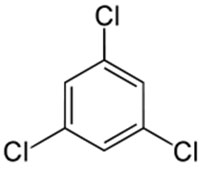 What is Trichlorobenzene?
What is Trichlorobenzene?
Trichlorobenzene appears as colorless liquid or white solid with a sharp chlorobenzene odor.
Uses
Trichlorobenzene is used as a dye carrier, an herbicide intermediate, a heat-transfer medium, a dielectric fluid in transformers, a degreaser, a lubricant, in synthetic transformer oils, and as a solvent in chemical manufacturing. Trichlorobenzene was formerly used as an insecticide against termites.
Sources & Potential Exposure
Occupational exposure to Trichlorobenzene may occur from inhalation during its manufacture and use. No information is available on the acute (short-term), chronic (long-term), reproductive, developmental, and carcinogenic effects of Trichlorobenzene in humans. Local irritation of the lungs and dyspnea have been reported in animals following acute inhalation exposure.
Chronic oral exposure has been observed to result in increased adrenal weights and vacuolization of the zona fasciculata in the cortex in rats. Liver effects have also been reported following chronic oral exposure in rats. Occupational exposure to Trichlorobenzene will result mainly from inhalation during its manufacture and use. The general population may be exposed by the consumption of contaminated drinking water and food, especially contaminated fish.
Federal Regulations
EPA has classified Trichlorobenzene as a Group D, not classifiable as to human carcinogenicity.

 Americas
Americas Europe
Europe Français
Français Deutsch
Deutsch Italiano
Italiano Español
Español
